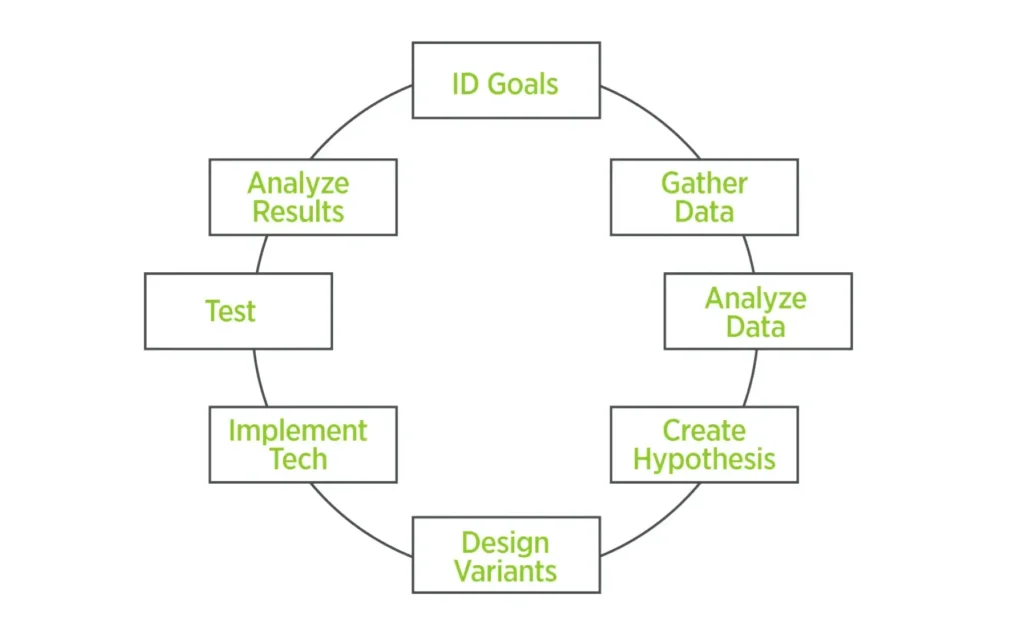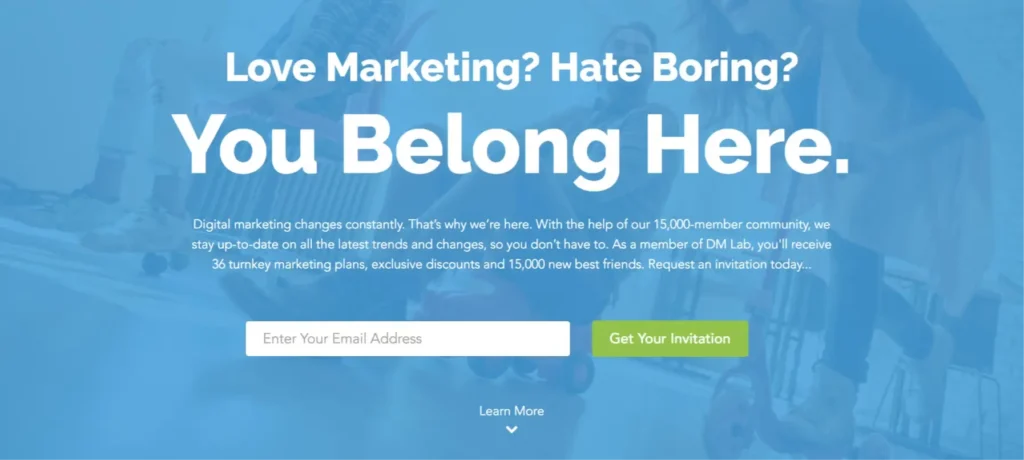Conversion doesn’t just mean a sale. It’s whatever you definite it, and unless you define what you mean by “conversion,” you can’t improve the experience.
Here’s the bottom line: if you want to improve your conversion rates, you must learn to articulate things better and improve the experience so people can perform the action you’re asking them to take. The main goal of optimization is to improve conversion rates of the traffic you already have, and generally, with the assets you already have.
It’s also important to understand that optimization is a dedicated, repeatable process. You’ll work through the process, then begin again. And since you can always improve your results—no matter how much you improve them—you’ll continue optimizing as long as you’re in business.
That’s why we describe the CRO process as a cycle:

You start by identifying your goals. You gather relevant data, analyze it, and create a hypothesis. You design your variants, implement technology and test your hypothesis. Then you analyze results, which will give you new insights and ideas for new tests. Then the process starts all over. With optimization and testing, this cycle never ends. Not if you’re doing it right, at least. Now let’s talk about what you’ll do at each stage of the cycle.
Identify your Goals
The process starts with a clearly articulated goal. Remember, without clear goals, you can’t optimize anything. You must know what you’re trying to achieve.
So let’s say you’re trying to optimize your homepage. Keep in mind, though, homepages are actually one of the most difficult pages to optimize because they’ve got to perform so many different tasks—and everyone wants to prioritize their own goals. The sales team is looking for qualified leads. The acquisition team is looking at how they can convert the traffic into emails. Everyone is competing for shelf space on the homepage.

But here’s the bottom line: A homepage is your “you are here” message for new visitors. They’re trying to figure out if your business is relevant to them, and if so, where they are and where they need to go.
To optimize this experience, you’ll need to set one or more of 3 goal types:
- An immediate goal, such as clicks or on-page form completion.
- A campaign goal, such as leads generated or purchases.
- A long-term goal, like impacting your long-term value, net revenue, average order value, or lead quality.
Gather Data
Once you’ve set your goal, you need to set a baseline for your metrics. For each, log your current number, your aspiring number (the number you’re aiming for), and your user data. Gather that data prior to making any assumptions. Which brings us to rule #1 for optimizers: leave all assumptions at the door. You and everyone else in your business have ideas about what works, what doesn’t work, what your visitors are looking for, and more. But those ideas are merely assumptions.
You must never make decisions based on assumptions. Test your ideas, and let your visitors tell you what works for them. So where do you get your data?
- For site metrics, go to Google Analytics.
- For user behavior metrics, use a tool like TruConversion.
- For customer and email data, use the data provided by your email service: ConvertKit, Infusionsoft, Aweber, etc.
- For payment data, look at your payment processor: Stripe, Paypal, etc.
Different types of data are shared in reports like this one from Google Analytics, which tells you about the traffic on the page you’re trying to optimize.
Analyze Data
The key to CRO success is to use relevant data (which you just gathered) to develop meaningful optimization campaigns.
Review your numbers and ask yourself questions like these:
- What’s my conversion rate? (And is it acceptable?) Use analytics or CRM data to find the answers.
- What’s hurting my conversion rate? Use the user behavior data to figure this out.
- How or why is it hurting my conversion rate? To answer this question, you’ll move to the next step in the CRO process and develop a hypothesis.
Develop Hypotheses
Develop Hypotheses
At this stage of the process, you have your data and you’ve identified the elements that are likely hurting your conversion rates. Now you need to make some guesses about how you could fix the issue you’ve identified.
How do you make a hypothesis?
It’s as simple as creating a statement containing these 3 elements:
- The change or approach you plan to test.
- Who you are targeting with this change.
- The outcome you expect to see.
The format should be something like this:
We believe that doing [1] for [2] will make [3] happen
Notice that your hypothesis is about your intent. You need to be very precise about the outcome you’re aiming for. You also need to be sure it’s something you can measure and will improve your results in a specific way.
Analyze Results
After running a test, you need to analyze the results. This gives you the “why” and fuels your next campaign. During this stage of the process, you perform 5 essential tasks:
- Share lifts or losses.
- Figure out “why”.
- Write a report.
- Archive your data.
- Share the results with stakeholders.
In your report, you want to include the name of the test, the timeline, metrics, visuals, show the variants, and break down the long-form numbers. Then move into what you learned from the test and what needs to be done as a result. During analysis, you need to ask these questions:
- Did you see a lift, loss, or a null?
- If results went against the hypothesis, why?
- Is it worth retesting? Maybe there were unusual circumstances around the test that make the results questionable.
- How can the data be used in future experiments?
Now, use these findings to set new goals and begin the process again.
References:
Digital Marketer. (n.d.). The Ultimate Guide to Digital Marketing. Course Hero. Retrieved January 25, 2022, from https://www.coursehero.com/file/94978188/Ultimate-Guide-to-Digital-Marketingpdf/

